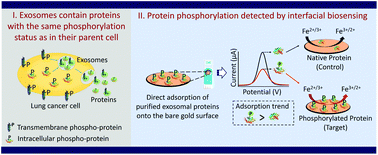An exosomal- and interfacial-biosensing based strategy for remote monitoring of aberrantly phosphorylated proteins in lung cancer cells†
Abstract
It is a well-known phenomenon that cancer cells release key biological information such as DNA, RNA or proteins into body fluids (e.g., blood, urine or saliva). The analysis of these molecules—often encapsulated within nanovesicules called exosomes—is highly attractive, because it could replace current surgical biopsies, which are painful, costly and potentially risky for patients. For example, current strategies in lung cancer diagnosis involve genetic analyses from tumour tissues to detect the presence of underlying DNA mutations, known to alter the phosphorylation status and function of proteins. This information is used to direct therapy, as aberrantly phosphorylated proteins are the main targets of current drugs such as Tyrosine Kinase Inhibitors (TKIs). An alternative and less invasive strategy would be the remote analysis of these phospho-proteins by isolating them from cancer-derived exosomes. This would allow evaluating not only their phosphorylation status at diagnosis, but also the timely restoration of protein phosphorylation levels during therapy with TKIs. Yet, this proteomic approach remains vastly unexplored. Herein, we demonstrate that key lung cancer phosphoproteins, such as EGFR and ERK, are expressed in lung cancer exosomes and we outline a new exosomal proteomic-based approach for their fast and convenient detection. This approach, which could complement current genetic analysis for lung cancer detection, easily detects the phosphorylation status of lung cancer exosomal proteins within minutes after their extraction, bringing hope of circumventing the need for tissue biopsy and costly and cumbersome DNA sequencing techniques. It exploits the fact that phosphorylation induces protein conformational changes, which in turn alter protein's ability to effectively interact with bare gold surfaces. This leads to phosphorylated and non-phosphorylated protein isoforms displaying different gold-adsorption profiles. Using single-use and inexpensive, gold (Au) screen-printed electrodes (SPEs), we demonstrate the successful detection of aberrantly phosphorylated EGFR and ERK protein isoforms derived from lung cancer cell exosomes with a sensitivity down to 15 ng μL−1 in samples with up to 90% excess of their non-phosphorylated (wild-type) forms. We further show the applicability of this strategy for monitoring the action of Tyrosine Kinase Inhibitors over time. We believe that this non-invasive technique will open up new avenues for facilitating cancer diagnosis and time-point monitoring of therapeutic responses.

- This article is part of the themed collection: Nanobiointerfaces


 Please wait while we load your content...
Please wait while we load your content...